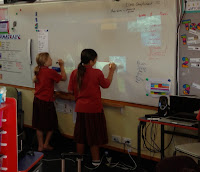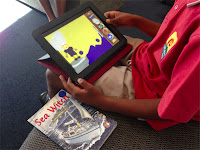Sarah is finding that students' work is of a much higher standard, the content is a lot better. Parents have told her that their children talk about what they do at school more than what they have ever before. She has noticed that there is a lot of discussion and sharing amongst the students as they talk about how they going to approach their work.
In reflecting on where the students were at the beginning of the year she said that students found it hard to have choices as they were used to being told what to do, now they know how to cope. I saw that with the task Sarah set today...students were given a time limit, expectations and from that they chose how they were going figure out how they were going define, find and present. Every group of 2 or 3 worked in a different way. Their task was to present what they knew about the '12 stations of the cross' and what was the meaning of each station to them.
Examples of what the students came up with are
- rewrote the words to Impossible by Shontelle and made their own lyric video by recording themselves playing the soundtrack, using the piano on Garageband, and writing the lyrics on Keynote to play at the same time

- one group made a PowerPoint where they found the information on the internet they needed, I got them to put the information into the 'Finding Relevant Text' Graphic Organiser, highlight the keywords and then write the text in their own words using the keywords
- some did a TV news report where they recorded themselves reading the news using the iPads and did further editing in Moviemaker

- one group did a front page for a newspaper
- a couple of groups made a movie acting out the the different parts of 12 stations
- several groups used Inspiration maps for recording their ideas
Diane's room layout is working well and she now has a couch that is hugely popular with the
students. She has been allowing students to have choice over what activities they want to do during Reading and Maths.
Because it 'Holy Week' for the Catholic church, students do a lot of work around the '12 Stations of the cross' so Diane had set the same task Sarah had. We had been talking about statistics and Diane was talking about how students could present their knowledge. I saw a great opportunity to talk about infographics. Diane could see how that could fit in with what she wanted students to do that afternoon. I shared with the students what infographics needed and we looked at the structure slideshow example. The students got a lot of good ideas of how to use symbols and different ways to show timelines.
I suggested to Diane that she made it a regular thing during the week to look at different infographics and analyse them using the examples I have curated on scoop.it








































